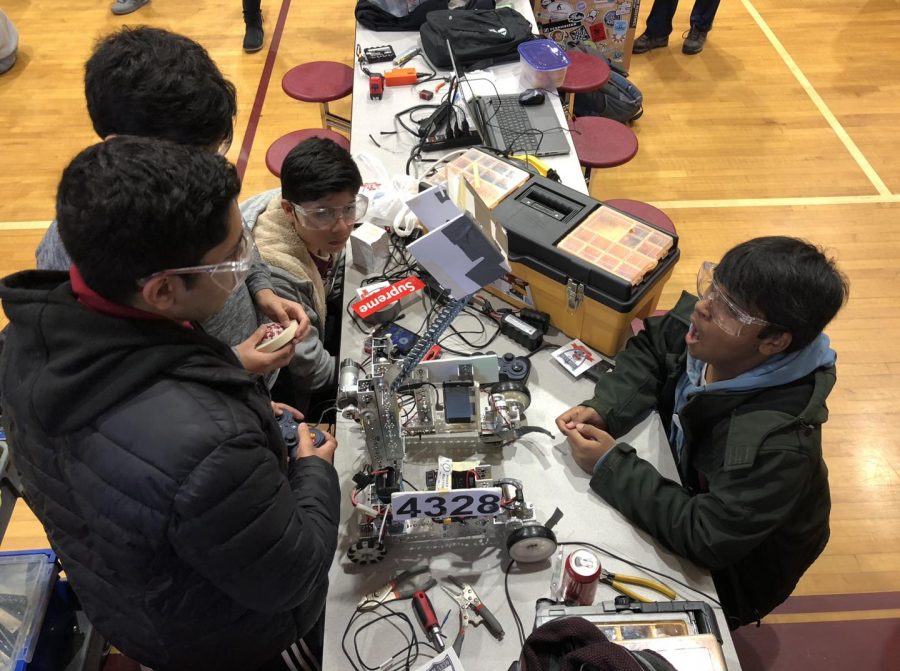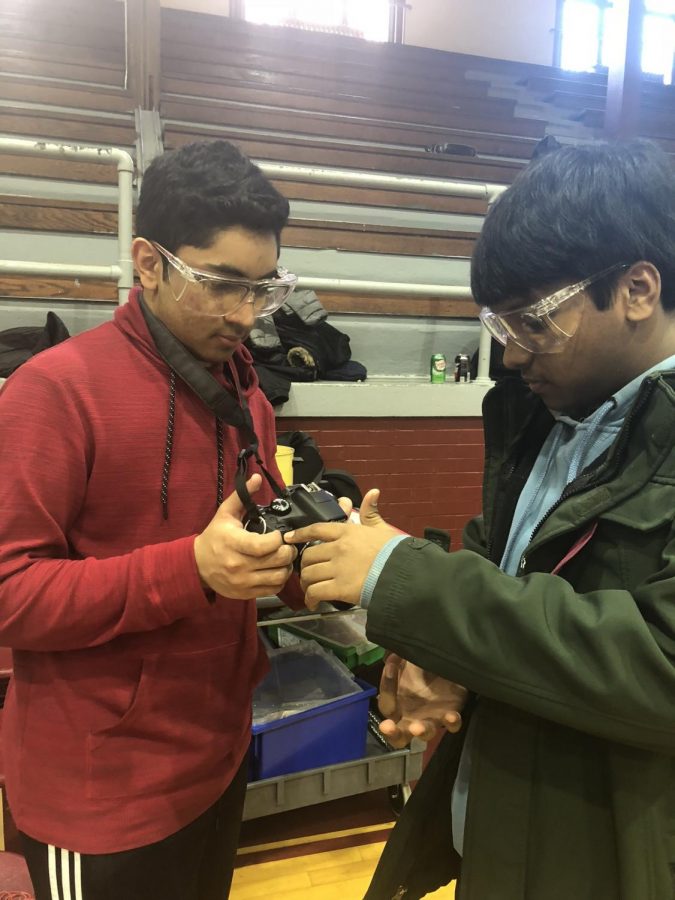4328 Placed 16th: DMAE Robotics
“My battery is low and it’s getting dark.” The last words of the Mars Opportunity Rover, this phrase signaled a poetic end to one of the most remarkable scientific expeditions ever undertaken. Originally meant to last just 90 days, the Rover shattered all expectations by traversing 28 miles of inhospitable terrain for 14 years. Despite facing many obstacles, Opportunity unearthed compelling evidence of ancient water on Mars.
Much like Opportunity, the school’s robotics team, headed by Randy Sherry and Shawn Cyran, has undergone many challenges. This was clearly evident during its first competition, the Northern Blast II Tournament, when the DMAE team C’est la Vie found out it was up against stiff competition. Yet, despite the obstacles of budget restrictions, team size, and practice space, the team placed 16th in a field of 28 teams and was proud to have co-hosted the event with Dwight-Englewood.
“This is our first event of the season and we finished in the middle of the pack. That is VERY good,” lead coach and DMAE Engineering teacher Mr. Sherry commented.
The 28 teams that competed in the Northern Blast were attempting to qualify for the state championships on March 10, 2019, amongst a crowd of 150-200 people. It was held on Saturday, Jan. 26, 2019, from 10:30 a.m. to 5 p.m. in the Dwight Morrow High School gym.
Four students represented DMAE at the tournament: Miguel Chica, Fizar Hossen, Sebastian Romero, and Richard Sawh. Mr. Sherry and Mr. Cyran were unable to attend, so Mr. Salvatore, Mr. Pennington, and Mr. Sawh stood in for them.
The four teams that advanced to the state championships were Critical Mass, WeByte, Cruise Control, and W.A.L.K.E.R.S. They were large, well-funded teams with fancy posters and matching outfits, but teams that also possessed considerable know-how.
“There is a lot of work that goes into every FTC team,” affirmed Kenneth Yan, a senior at Dwight-Englewood and the captain of Critical Mass.
Kenneth explained that while designing and programming a robot is the most important aspect, there is also a substantial amount of other work involved such as fundraising, putting together an engineering notebook, and community outreach.
“The challenge we and many other teams face is organizing and doing all of this efficiently, but it is a very rewarding process,” Kenneth said.
There were 35 matches with every team playing in five of them. C’est la Vie struggled in its early matches. The robot malfunctioned and did not move at all in the first match, and the robot’s claw was damaged in the second match. However, they performed capably in their later matches after they were able to fix the major problems at the pit stop. Their overall record was 2 wins and 3 losses.
“We have the passion, but not the budget. If we had the budget, we could rival the top teams,” sophomore Richard Sawh remarked.
The Northern Blast II Tournament was part of a series of similar competitions happening around the world under FIRST Tech Challenge’s (FTC) guidance. Since 2005, FTC has encouraged students in grades 7-12 to collaborate in designing and programming robots for competing with and against other teams.
This year’s game mode was Rover Ruckus, inspired by the upcoming 50th anniversary of the Apollo 11 moon landing. The game is essentially a space adventure played between a red alliance and a blue alliance. Each alliance is comprised of two randomly picked teams and their robots for a total of four teams and four robots on the field. During a single match, the “rovers” (robots) land on a “planet” (12 ft x 12 ft field) and need to complete specific tasks such as collecting gold and silver “minerals” (yellow cubes and plastic balls) from “craters,” placing them into the correct “depots” and “cargo holds,” and finally “blasting off” from the planet all within the span of two minutes and thirty seconds.
“It’s not BattleBots,” Mr. Sherry remarked humorously.
The night before the competition, DMAE and Dwight-Englewood students and advisors set up the two gyms into a playing area, where the matches took place, and a pit area, where teams could fix and recharge robots in-between matches. On top of that, the teams arrived at 8 a.m. to prepare their robots.
“It’s a whole sequence that happens,” Mr. Sherry commented from past experiences. “No one really notices, but there’s a lot of tension in the morning, people running around, saying ‘The screw’s hitting the ground!’or ‘Quick, hurry up, quick!’ or ‘It doesn’t fit in the box!’ or ‘Cut that piece off!’ It’s really nice for us, because we get what’s going on.”
In the end, C’est la Vie was not discouraged by the results of the tournament. After a month of refining the robot, they believe they have had enough practice and preparation for their future tournaments and are expecting more positive results.
“Honestly, building robots, you think it’s a lot harder than it really is but you just kind of mess around with everything and try to make it work,” Richard concluded.

Devin Kim is a junior in the Information Systems Academy, and his second year writing for The Maroon Tribune. Besides his work as a student reporter, he...




